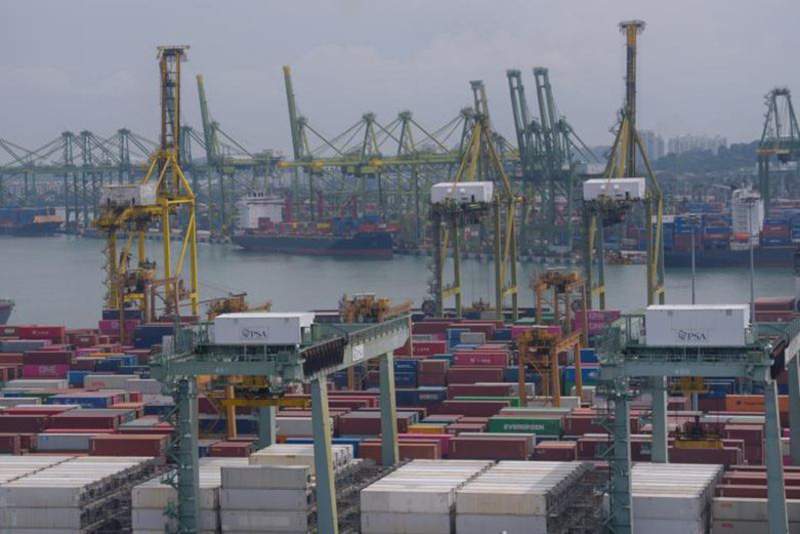
Singapore has retained its position as the top bunkering port.
19:13 JST, January 21, 2022
A record 37.5 million 20-foot equivalent units (TEUs) of containers passed through Singapore’s ports last year, making it the busiest transshipment hub in the world.
The latest figures released by the Maritime and Port Authority of Singapore (MPA) on Jan. 13 showed that this translated to some 599 million tons of cargo that was handled here, as Singapore proved resilient amid COVID-19 and a supply chain crisis that disrupted regular shipping patterns.
At the same time, refueling sales figures also crossed 50 million tons for only the second time in history, comprising both conventional bunker sales and liquid natural gas bunker sales, which has been put forward as a more environmentally sustainable alternative.
This allowed Singapore to retain its position as the top bunkering port, and bunkering sales likewise exceeded both those logged in 2019 and 2020.
“The Port of Singapore remained open and connected to the world in 2021 despite the ongoing COVID-19 pandemic,” the MPA said. “We will continue to diversify our fuel offerings in line with our push for maritime decarbonization.”
“This is a strong testament of Singapore’s performance in not only the port sector, but also as an international maritime center in shipping services and maritime technology.”
When COVID-19 struck, the impact on Singapore’s port operations, although not as severe as that on air transport, still made a dent in container throughput.
The year 2020 saw ports here handling 0.3 million TEUs fewer containers compared with the previous high of 37.2 million TEUs in 2019.
But the country positioned itself as a catch-up port to help other container ships reroute and shorten journeys when the supply chain crisis hit late last year, and the number of containers it processed rebounded strongly.
The 37.5 million TEUS container volume last year was 0.6 million TEUs higher than in 2020, and much higher than the 31.6 million TEUs recorded at the start of the decade.
Transport Minister S. Iswaran said that the results made him confident that Singapore’s ports were well placed to recover after COVID-19, and can become stronger amid fiercer competition from worldwide ports.
At the Singapore Maritime Foundation New Year Conversations event on Thursday, he said the rise of Asia meant more resources and goods will flow into Asia to meet growing middle-class demand.
To capture market share, Singapore must continue to invest in digitalization and attract talent, he added.
Mr. Iswaran said at the event held at Orchard Hotel: “This year, we will progressively roll out new port systems and programs to drive maritime digitalization … Amid the so-called ‘Great Resignation’ in many countries, the maritime sector will need an attractive package — of wages, benefits and career progression — to attract and groom talent.”
Dr. Yap Wei Yim, head of the international trade management minor program at the Singapore University of Social Sciences, said Singapore’s container throughput should reach about 40 million TEUs of containers this year, and exceed the 50 million TEUs mark before the end of the decade, barring major setbacks to the world economy.
“Singapore’s performance is consistent with the trend seen for many ports around the world,” he said.
“We saw flight cancellations and cities undergoing lockdowns in the pandemic. However, ships continue to sail and goods continue to move. In many cases, the port and shipping industry literally became the lifeline to many countries and cities.”
He said Singapore is one of the few ports, if not the only port, in the world that has managed to secure joint venture investments from the world’s three container shipping alliances, which together account for more than 80% of the world’s vessel capacity.
These three shipping alliances — Ocean Alliance, The Alliance and 2M — invest in berths here, which ships under their alliance then have priority to use. Dr. Yap estimates vessels in these three alliances contributed to about half of Singapore’s container figures last year.
Nanyang Technological University’s associate professor of sustainable maritime operations Jasmine Lam said Singapore’s performance was closely linked to how it adapted amid the COVID-19 and supply chain crises.
By continuing to be reliable and efficient, Singapore managed to capture traffic from neighboring ports in Malaysia, Thailand and Indonesia that were congested.
With global maritime trade increasing as a whole, Singapore’s container throughput figures will only go up, said Prof. Lam.
“Singapore had the fastest turnaround among all ports in South-east Asia. With Tuas Port opening up soon, Singapore will also have greater capacity to deal with more containers,” she said.
“Bunkering sales are very closely tied to how many ships come to Singapore, since they must refuel when they are here. Singapore’s productivity and reputation mean both numbers will increase.”
"World" POPULAR ARTICLE
-

8 Japanese Nationals Stranded on Indonesia’s Sumatra Island
-

Mozambican Cooking Class Held in Matsuyama, Ehime Pref.; Participants Don Aprons, Bandanas Made from Traditional Mozambique Fabric
-

U.S. Senate Resolution Backs Japan, Condemns China’s Pressure
-

China to Impose Sanctions on Shigeru Iwasaki, Former Head of Japan’s Self-Defense Forces, Who Serves as Adviser to Taiwan’s Executive Branch
-

South Korea’s Top Court Dismisses Nippon Steel Appeal in Lawsuit over Requisitioned Worker
JN ACCESS RANKING
-

Tokyo Economic Security Forum to Hold Inaugural Meeting Amid Tense Global Environment
-

Keidanren Chairman Yoshinobu Tsutsui Visits Kashiwazaki-Kariwa Nuclear Power Plant; Inspects New Emergency Safety System
-

Imports of Rare Earths from China Facing Delays, May Be Caused by Deterioration of Japan-China Relations
-

University of Tokyo Professor Discusses Japanese Economic Security in Interview Ahead of Forum
-

Japan Pulls out of Vietnam Nuclear Project, Complicating Hanoi’s Power Plans






















